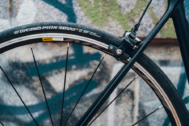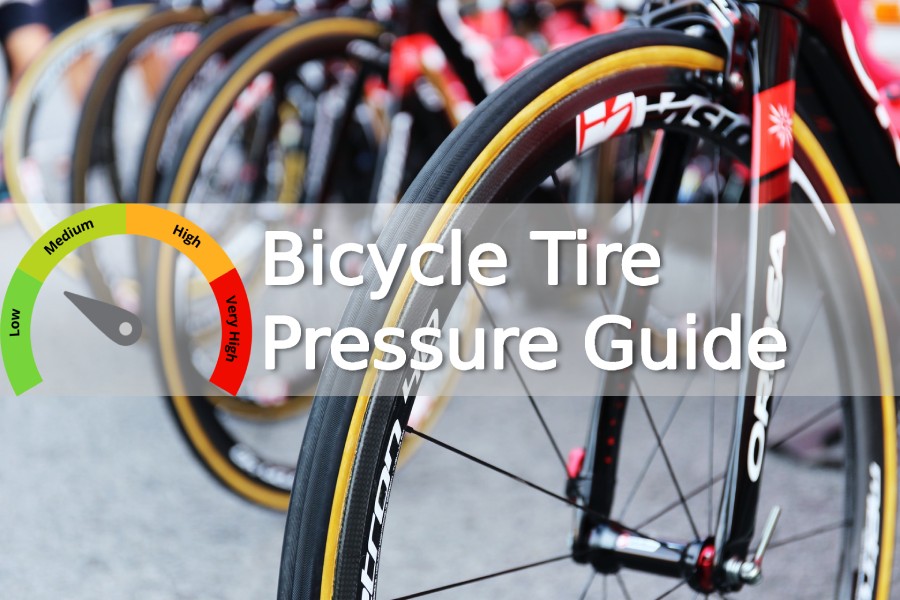
The question “what pressure should bike tires be?” is complex, but using an appropriate tire pressure is a fast, cost-free way to optimize your bike’s performance.
Bike tire pressure significantly influences how your bicycle feels and performs on the road or trail. Traction, speed, and comfort are the three areas affected the most.
The ideal bike tire air pressure attributes to a comfortable, fast, and controlled ride, whatever conditions arise. Conversely, inappropriate pressure increases fatigue and the risk of punctures and reduces speed.
The factors that determine appropriate tire pressure in any given situation include tire width, rider and bike weight, conditions and terrain, and whether the tires are tubeless or not.
This article will outline tire pressure ranges for different disciplines and the performance characteristics and essential points for measuring and managing pressure.
Things to Consider Before Delving Deeper
What is PSI?
Pounds per square inch (psi) is the standard international tire pressure measurement. It indicates the level of pressure and stress (caused by air) in a pressurized tube such as a bike or car tire. The alternative metric measurement you may see is Bar.
- Higher psi (more pressure) = A harder, rigid tire
- Lower psi (less pressure) = A softer, malleable tire
Why bother with bike tire pressure?
As we touched on in the introduction, tire psi significantly influences traction, rolling speed, and comfort. Each tire has a psi range indicated by the manufacturer, which riders should stay within, but either side of this range will produce different results.
- Underinflated tires = Reduced speed, more prone to pinch flats, better grip and comfort
- Correctly inflated tires = Fast-rolling, sufficient grip, good shock absorption
- Overinflated tires = Sometimes slower, less grip and comfort
Running lower pressure increases bicycle rolling resistance and traction because more tire surface is in contact with the ground, absorbing more vibration from impacts. Low PSI is beneficial for wet weather, rough surfaces, or sharp cornering.
Running higher pressure decreases rolling resistance and traction, typically increasing speed (on smooth surfaces). However, more vibrations reach the rider, reducing comfort and increasing the rate of fatigue.
Know your valve type
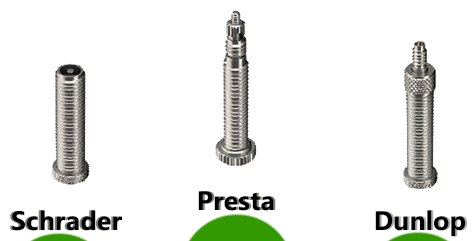
Know which valve type your bike has and use the correct pump.
Find out which valve type you have and choose the corresponding pump to operate it correctly.
- Schrader (cars) – Shorter, thick valve. Pump nozzle screws on to lock
- Presta – Tall and narrow. The top piece twists up, and then the pump nozzle is pressed firmly on
- Dunlop – Less common valve, tall and thick. Pump using a Schrader adapter
- Tubeless – Valve mounts to the rim. Connector varies
Presta vs Schrader Valves: What are the main differences between these valve types?
High-pressure vs. High Volume Bike Pumps vs. CO2 Inflators
High-pressure pumps – For high psi, narrow tires (road). They efficiently resist the pressure trying to escape the tube while pumping, so you can achieve a higher PSI.
High-volume pumps – For wide tires that require more air. They are easier to use but ineffective for high psi.
CO2 inflators – Small pressurized gas canisters rapidly inflate tires without pumping. These are an excellent tool for roadside repairs but inefficient for at-home use as CO2 leaks quickly.
More doesn’t always mean faster
Wider tires with lower air pressure are faster on rough surfaces than hard, high psi tires. The suspension gains of low psi reduce bouncing by absorbing the energy of impacts, allowing riders to maintain momentum. Hence, most professionals are transitioning from 23mm to 25mm or 28mm road tires.

Image: conti-tyres.co.uk
As you can see from the image above, a 28mm tire at 80 psi has the same rolling resistance as a 25mm tire at 90 psi or a 23mm tire at 120 psi. Therefore, a narrower tire pumped to crazy pressures is not necessarily faster, even though that’s what was considered to be true for a long time.
How often should I check my bike tire pressure?
High-pressure tires leak air faster than low-pressure ones. Given that, here are some averages:
- Road riders – Ideally check before each ride or at minimum once a week
- MTB riders – Check every one to two weeks
Check more often if you ride frequently.
Don’t trust the floor pump gauge
Most floor pump gauges measure the pressure inside the pump, not the tire. As a result, they give a good estimation but aren’t accurate.
A needle-style bike tire pressure gauge is the most precise measurement tool. That said, the gauge on a floor pump is adequate for most riders.
Recommended Tire Pressures by Bike Type
Various factors influence how much air pressure to use in bike tires, including tire width and diameter, bike weight, rider and cargo weight, weather conditions, terrain, and tubeless tires.
We will define broad ranges for individuals weighing 120 -200lb, adjust up or down for your weight, and the other variables. If you are outside that weight range, adjust further.
Each discipline has a range that maximizes the specific traits required for performance. A bike tire pressure calculator is the most accurate way to determine psi, but we’ve given some estimate ranges below.
Mountain Bike Tire Pressure
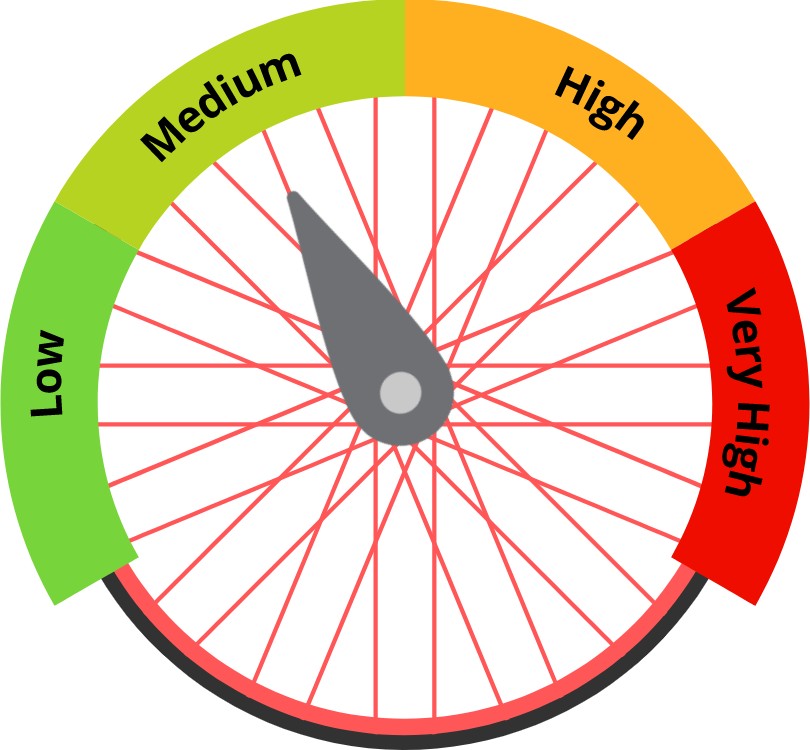
Mountain bike tire pressure is the most complex because of the number of variables, including tire widths (2.1″ – 2.8″), disciplines (XC, Trail, Enduro, DH), terrains, and MTB wheel sizes. In addition, individual preferences contribute heavily to mountain bike tire psi.
The gravity disciplines require higher PSI to maintain rolling speed and avoid flats when taking big hits. In contrast, a lower PSI may be favorable for enduro riding on loose terrain when grip is a priority.
Here a the MTB tire pressure ranges in terms of tire width:
- 2.1″ = 18 -26psi
- 2.25″ = 17 – 25psi
- 2.35″ = 16 – 31psi
- 2.4″ = 16 – 31psi
- 2.5″ = 15 – 30psi
- 2.6″ = 14 – 23psi
- 2.8″ = 14 – 22psi
Road Bike Tire Pressure
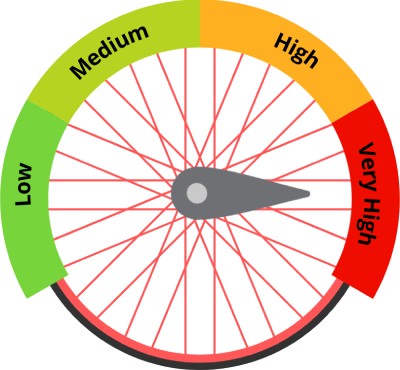
Road bike psi varies a lot in terms of the total number. As most roads aren’t perfectly smooth, a mid-to-low road bike tire pressure can improve speed because grip increases, vibration fatigue decreases, and momentum losses are lessened.
Additionally, run a lower bicycle tire PSI in wet weather to improve grip or very bumpy terrain (cobblestones) for comfort. However, don’t go below the recommended range, or pinch punctures occur.
- 23mm = 92 – 116psi
- 25mm = 80 – 104psi
- 28mm = 72 – 96psi
- 30mm = 63 – 84psi
Commuter Bike Tire Pressure
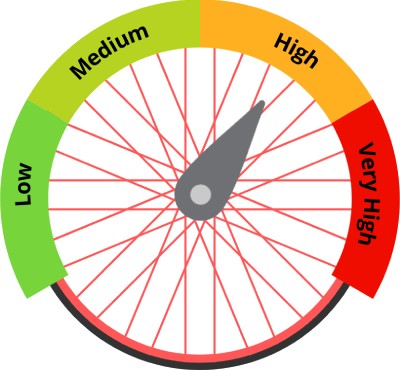
Commuter and hybrid bike tire pressure lies in the middle of the road and MTB ranges.
Rider preferences and terrain are the two primary considerations; performance is not significant for commuter or hybrid riders.
Because performance is less of an issue, you can allow more flexibility in the ranges. In addition, many commuters carry cargo requiring an extra 2-4psi per 10lbs of cargo.
Maintain a mid to high PSI for fast commutes on smooth city roads; experiment with the lower end of the range for mixed terrain and frequent wet weather.
- 35mm = 50 – 80psi
- 38mm = 40 – 70psi
Gravel Bike Tire Pressure
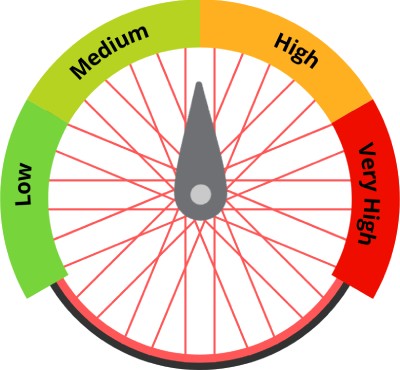
Gravel tires typically range from 35mm to 50mm in width. While the sizes are similar to hybrid bikes, gravel riders run lower psi to boost comfort and performance on rough terrain.
Experiment with a lower psi to find the gravel bicycle tire pressure for better rolling speed, grip, and comfort on heavy gravel paths and mountain trails. The higher end of the ranges should provide adequate comfort and grip, boosting rolling speed if you mainly ride light gravel paths and roads.
- 32-35mm = 30 – 48psi
- 38-42mm = 23 – 40psi
- 45-50mm = 19 – 33psi
Fat Bike Tire Pressure
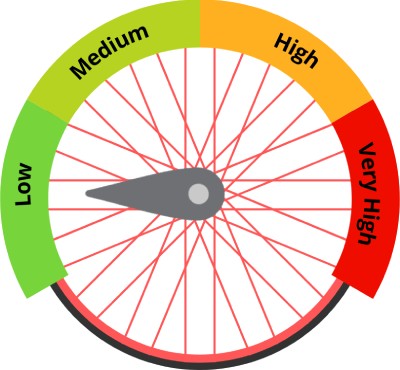
Aside from cyclocross racing, fat biking encompasses the broadest range of surfaces, including soft terrains like mud, sand, and snow or harder terrains like mountain trails and gravel.
For soft terrain rides, it’s best to use a lower psi so you don’t get bogged down easily and can maintain grip. Conversely, on mixed terrain days or regular hardpack riding, increase the psi to reduce rolling resistance and improve speed.
- 3.8-4.0″ = 4 – 7psi
- 4.5-4.8″ = 3.5 – 6.5psi
- 5.0″ = 2.5 – 5.5psi
Kids’ Bike Tire Pressure
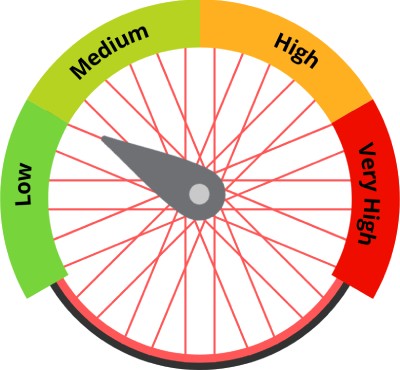
Kids’ tire pressure should always trend toward the low end of the range printed on the tire wall. The lower pressure is because kids’ are light, and they benefit from the added grip and comfort of a low psi, promoting enjoyable and confident riding.
For more experienced children and those riding just on pavement, raising the psi to reduce rolling resistance on smooth surfaces is acceptable. Kids’ wheel sizes and weight vary greatly, so take these estimates lightly and consult the manufacturer’s recommendations.
- Mountain bike = 18 – 36
- Hybrid bike = 30 – 60
Factors That Influence Ideal Bike Tire Pressure
Aside from performance factors, maintaining a minimum pressure ensures you don’t bottom out, and the tire bead doesn’t separate from the rim. However, if you go too low, you risk pinch punctures. Furthermore, don’t exceed the max pressure, or you may blow the tire.
Tire Size & Width

Tire size and width greatly influence how much pressure you should run. The wider the tire, the more air volume and less air pressure it requires.
The size and width of a tire change the total volume. The tire’s volume (how much air it holds) is the primary determinant of the psi.
Higher volume = lower psi.
From reading this article, you may have noticed the psi range decreases as the tire width increases. The same goes for larger diameter tires.
Manufacturer Recommendations
If you ever wonder, “what should bike tire pressure be?” each manufacturer prints a recommended bike tire psi on the sidewall. Always stay within the range provided to the abovementioned avoid issues when riding.
If you have old tires and don’t see the range, it may have worn off, so check the tire model on the manufacturer’s website. Place the pressure rating beside the valve for easier reference when installing new tires for quick reference.
>>>Related: Schwalbe Tires Review
Front vs. Rear Tire Weight Load
In general, 55-60% of a rider’s weight sits over the bike’s rear wheel. Use a slightly lower pressure (5%-10%) in the front tire to account for this.
Tubes vs. Tubeless
Tubeless tires are becoming increasingly popular across most disciplines, especially off-road ones (MTB and gravel). A sealant creates an airtight lock between the tire bead and the rim and ensures the valve stem is sealed and airtight.
Clincher vs Tubular vs Tubeless Tires — All Differences Explained
These tires don’t use an inner tube. As a result, they run at considerably lower psi without risking pinch punctures.
Bicycle and Rider Weight
When you sit on a bike, gravity causes the tire to compress. A heavier rider causes more compression, thus requiring more air pressure to counteract it. Adjust the psi higher or lower (within the manufacturer’s range) based on your weight.
Riding Conditions

The correct tire pressure depends on the terrain and surface. For optimal comfort and grip on rough terrain, make sure to decrease the tire pressure. Image: The Pros Closet
Different terrain and riding conditions require adjustments to psi. For example, for better comfort on rough terrain or traction in wet or muddy conditions, adjust the psi down. On the other hand, a higher psi will provide enough traction and comfort and potentially a speed boost on smooth terrain.
Finding the perfect psi for your typical routes and riding conditions takes experimentation.
Subjective Feel & Priorities
If you’re still asking yourself, “what should bike tire pressure be?” trial and error is the only way to find your preferred psi. Additionally, your preferences may change depending on the conditions, route, or how you’re feeling on the day.
Remember, the speed trade-off from lower psi is slight. If in doubt, err on the low end of your weight/manufacturer’s range and use a bike tire pressure calculator for an accurate calculation.
FAQ
How to check bike tire pressure?
Connect your gauge to the valve by screwing on (Schrader) or pushing it down (Presta). It will then display a pressure reading. Use a needle-style gauge for the most accurate read.
How to put air in bike tires?
Use a pump or a CO2 inflator. Connect the head of the pump or inflator to the valve and either manually pump to inflate or twist a gas canister into the inflator which fills it automatically.
What is the proper tire pressure for a road bike?
The typical range for an adult road bike is between 60 to 120psi. See above for specific ranges based on road tire width.
What is the ideal tire pressure for a mountain bike?
The range for an adult MTB is 14 to 31psi. See above for specific ranges based on MTB tire width.


